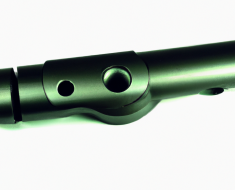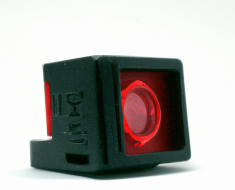Enhance your handgun’s performance with a new guide rod upgrade.
Benefits of Upgrading Your Handgun’s Guide Rod
When it comes to upgrading your handgun, one component that often gets overlooked is the guide rod. The guide rod plays a crucial role in the functioning of your handgun, so it’s important to consider whether upgrading it could benefit you in any way.
One of the main benefits of upgrading your handgun’s guide rod is increased durability. Most factory guide rods are made from plastic or low-quality metal, which can wear out over time with heavy use. By upgrading to a higher-quality guide rod, such as one made from stainless steel or tungsten, you can increase the lifespan of your handgun and ensure that it continues to function smoothly for years to come.
Another benefit of upgrading your handgun’s guide rod is improved recoil control. The guide rod helps to absorb and redirect the recoil energy generated when firing a round, which can affect your accuracy and follow-up shots. A higher-quality guide rod can help to reduce felt recoil and muzzle flip, allowing you to maintain better control over your handgun and improve your shooting performance.
In addition to increased durability and improved recoil control, upgrading your handgun’s guide rod can also enhance its overall performance. A stiffer guide rod can help to reduce barrel tilt and improve lockup consistency, leading to tighter shot groups and more consistent accuracy. This can be especially beneficial for competition shooters or anyone looking to maximize their handgun’s potential.
Furthermore, upgrading your handgun’s guide rod can also provide customization options that may not be available with a factory component. Many aftermarket guide rods come in different lengths, weights, and finishes, allowing you to tailor your handgun to suit your preferences and shooting style. Whether you prefer a heavier guide rod for added stability or a longer one for increased slide travel, there are plenty of options available to help you fine-tune your handgun to perfection.
In conclusion, there are several compelling reasons why you should consider upgrading your handgun’s guide rod. From increased durability and improved recoil control to enhanced performance and customization options, a higher-quality guide rod can make a significant difference in how your handgun handles and performs. Whether you’re a casual shooter looking to extend the life of your firearm or a competitive marksman seeking every advantage possible, upgrading your handgun’s guide rod is definitely worth considering. So why not take the plunge and see what a difference it can make for you?
Different Types of Guide Rod Upgrades Available
If you are a handgun owner, you may have heard about upgrading your guide rod. But is it really necessary? And if so, what are the different types of guide rod upgrades available? Let’s explore this topic in more detail.
First of all, let’s discuss what a guide rod actually does. The guide rod is a component of a semi-automatic handgun that helps to support and guide the recoil spring during the cycling of the slide. This helps to ensure smooth and reliable operation of the firearm.
One common type of guide rod upgrade is replacing the factory plastic guide rod with a metal one. Metal guide rods are often touted as being more durable and long-lasting than their plastic counterparts. They are also believed to provide better stability and consistency in cycling the slide.
Another popular option is upgrading to a captured or dual-captured guide rod. Captured guide rods feature a spring that is retained on the guide rod itself, making disassembly and reassembly easier. Dual-captured guide rods have two springs, which can help to reduce recoil and muzzle flip during firing.
Some handgun owners choose to upgrade their guide rods with tungsten or stainless steel versions. Tungsten guide rods are heavier than traditional steel ones, which can help to reduce felt recoil and muzzle flip. Stainless steel guide rods are corrosion-resistant and can add some weight to the front end of the gun, potentially improving balance and accuracy.
There are also aftermarket guide rods that feature different finishes, such as Cerakote or DLC (Diamond-Like Carbon). These finishes can provide added protection against wear and corrosion, as well as giving your handgun a unique look.
When considering whether to upgrade your handgun’s guide rod, it’s important to weigh the potential benefits against the cost. While some shooters swear by aftermarket guide rods and claim improved performance, others may not notice much of a difference. Ultimately, the decision to upgrade your guide rod will depend on your personal preferences and shooting style.
In conclusion, there are several different types of guide rod upgrades available for handguns. Whether you choose a metal guide rod, captured design, tungsten or stainless steel material, or a custom finish, there are options to suit every shooter’s needs. If you are looking to improve the performance or aesthetics of your handgun, upgrading your guide rod may be worth considering. Just be sure to do your research and choose a reputable manufacturer for any aftermarket parts.
How to Properly Install a New Guide Rod in Your Handgun
If you’re a handgun owner, you may have come across the idea of upgrading your guide rod. But is it really necessary? And if you do decide to upgrade, how do you properly install a new guide rod in your handgun?
First, let’s talk about why you might want to upgrade your guide rod. The guide rod plays a crucial role in the functioning of your handgun, helping to guide the movement of the slide and ensuring smooth operation. A high-quality guide rod can improve the overall performance of your handgun, providing better stability and reducing recoil.
There are several reasons why you might consider upgrading your guide rod. For one, stock guide rods are often made from plastic or other low-quality materials that can wear out over time. By replacing it with a higher-quality metal guide rod, you can increase the durability and longevity of your handgun.
Additionally, aftermarket guide rods are available in different weights and lengths, allowing you to customize your handgun to suit your preferences. A heavier guide rod can help reduce muzzle flip and felt recoil, while a longer guide rod can improve accuracy by providing more stability.
So, if you’ve decided to upgrade your guide rod, how do you go about installing it properly? The process may vary depending on the make and model of your handgun, so it’s important to refer to the manufacturer’s instructions for specific guidance. However, here are some general steps to help you get started:
1. First, ensure that your handgun is unloaded and the magazine is removed. Safety should always be your top priority when working on firearms.
2. Disassemble your handgun according to the manufacturer’s instructions. This usually involves removing the slide from the frame.
3. Locate the existing guide rod in your handgun and carefully remove it by following the appropriate steps. Be sure to keep track of any springs or other components that may be attached to the guide rod.
4. Install the new guide rod by carefully inserting it into place and ensuring that it is properly aligned with the slide and frame.
5. Reassemble your handgun according to the manufacturer’s instructions, making sure that all components are securely in place.
6. Test fire your handgun to ensure that the new guide rod is functioning properly. Pay attention to any changes in performance or feel compared to the stock guide rod.
By following these steps and taking proper precautions, you can successfully install a new guide rod in your handgun and enjoy improved performance and functionality. Remember to always consult the manufacturer’s instructions and seek professional help if needed.
In conclusion, upgrading your handgun’s guide rod can be a worthwhile investment if you’re looking to enhance its performance and durability. By choosing a high-quality aftermarket guide rod and installing it properly, you can customize your handgun to suit your preferences and enjoy a smoother shooting experience. Just remember to prioritize safety at all times and follow proper procedures when working on firearms.
Potential Drawbacks of Upgrading Your Handgun’s Guide Rod
If you’re an avid shooter or gun enthusiast, you may have come across the idea of upgrading your handgun’s guide rod. While this can seem like a tempting option to improve the performance of your firearm, there are potential drawbacks that you should consider before making any changes.
One of the main concerns with upgrading your handgun’s guide rod is the risk of voiding your warranty. Most manufacturers have strict policies regarding modifications to their firearms, and changing out the guide rod could potentially result in your warranty being voided. This means that if anything were to go wrong with your gun in the future, you would be left to cover the costs of repairs or replacements on your own.
Another potential drawback of upgrading your handgun’s guide rod is the risk of causing malfunctions or damage to your firearm. Guide rods are a crucial component of a handgun’s operation, and changing out the factory-installed rod with an aftermarket option could disrupt the balance and function of the gun. This could lead to misfeeds, jams, or even more serious issues that could compromise the safety and reliability of your firearm.
In addition, upgrading your handgun’s guide rod could also affect the resale value of your gun. Many collectors and buyers prefer firearms that are in their original condition, as modifications can raise questions about the gun’s history and performance. If you ever decide to sell or trade your handgun in the future, having an upgraded guide rod could limit your options and potentially decrease the value of your firearm.
Furthermore, upgrading your handgun’s guide rod may not always result in the performance improvements you were hoping for. While some shooters claim that aftermarket guide rods can improve accuracy, reduce recoil, or enhance durability, these benefits may not always be noticeable or significant enough to justify the cost and effort of making the change. In some cases, upgrading your guide rod could even lead to decreased performance or reliability, especially if the new rod is not compatible with your specific handgun model.
Overall, while upgrading your handgun’s guide rod may seem like a simple way to enhance your shooting experience, there are potential drawbacks that should not be overlooked. From voiding warranties and risking malfunctions to affecting resale value and potentially not seeing any tangible benefits, there are several factors to consider before deciding to make any modifications to your firearm.
If you’re still interested in upgrading your handgun’s guide rod, it’s important to do thorough research on compatible options and consult with a qualified gunsmith or firearms expert before making any changes. By weighing the potential drawbacks against the perceived benefits and taking precautions to ensure proper installation and compatibility, you can make an informed decision about whether upgrading your handgun’s guide rod is worth it for you.
Considerations Before Deciding to Upgrade Your Handgun’s Guide Rod
If you’re an avid shooter, you may have considered upgrading various components of your handgun to improve its performance. One component that often gets overlooked is the guide rod. While it may seem like a small and insignificant part, the guide rod plays a crucial role in ensuring your handgun functions properly.
Before you decide to upgrade your handgun’s guide rod, there are several factors you should consider. First and foremost, you need to determine if your current guide rod is causing any issues with your handgun’s performance. If you’re experiencing malfunctions such as failure to feed or eject, a worn-out or damaged guide rod could be the culprit.
Another factor to consider is the material of the guide rod. Most handguns come equipped with a stock guide rod made of steel or polymer. While these materials are perfectly fine for most shooters, some may prefer to upgrade to a guide rod made of a higher-quality material such as stainless steel or tungsten. These materials are known for their durability and ability to reduce recoil, resulting in improved accuracy and control.
Additionally, you should consider whether upgrading your guide rod is worth the investment. Aftermarket guide rods can vary in price, with some costing upwards of $50 or more. Before making a decision, weigh the potential benefits of upgrading against the cost. If you’re a competitive shooter or rely on your handgun for self-defense, the improved performance may be well worth the investment.
It’s also important to consider the compatibility of the aftermarket guide rod with your specific handgun model. Not all guide rods are universal, so make sure you choose one that is designed to fit your firearm. Some manufacturers offer custom-fit guide rods for popular handgun models, ensuring a seamless installation process.
Before making any upgrades to your handgun, it’s always a good idea to consult with a professional gunsmith. They can provide valuable insight into whether upgrading your guide rod is necessary and help you choose the right option for your specific needs. A gunsmith can also assist with the installation process if you’re not comfortable doing it yourself.
In conclusion, upgrading your handgun’s guide rod can be a worthwhile investment if you’re looking to improve performance and reliability. Consider factors such as functionality, material, cost, compatibility, and seek advice from a professional before making any decisions. With the right upgrades, you can take your shooting experience to the next level and enjoy improved accuracy and control with your handgun.





